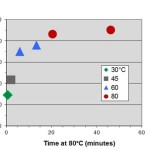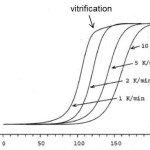Best Wishes for a Safe and Relaxing Thanksgiving Holiday. ... [Click to Continue...]
Thermoset Cure Kinetics Part 5: Time-Temperature Superposition Kinetics
Guest Post by Dr. R. Bruce Prime In previous posts in this series we have described basic kinetic principles, how to measure activation energy E and its constancy or variation with conversion, and the role of isothermal DSC in kinetic analyses. Here we add yet another tool: time-temperature superposition or TTS kinetics. TTS kinetics was introduced in the June 2, 2014 post. ... [Click to Continue...]
Thermoset Cure Kinetics Part 4: Isothermal DSC
Guest Post by Dr. R. Bruce Prime In previous posts we showed how to begin a kinetic study and one means to measure activation energy E. Here we show how DSC may be used to measure the parameters in the rate equations, a and da/dt, that can lead to elucidation of the entire rate equation, including another means to measure E. Because DSC gives a direct measure of both the ... [Click to Continue...]
Veterans Day Tribute
Thanks to all our veterans and current active duty military. We are all deeply indebted to your service to preserve our freedom. An additional thanks to my son-in-law Sergeant Nate Holmes, USMC, an active duty Marine who served two deployments in Iraq and is currently serving in Southern California. ... [Click to Continue...]
Thermoset Cure Kinetics Part 3: Multiple Heating Rate Kinetics
Guest post by Dr. R. Bruce Prime In Part 2 of this series we introduced the concept of multiple heating rate kinetics. Here we delve into the details of this method, both the principles and how it can be used to measure not only the activation energy (E) but also the constancy of E as a function of conversion, Ea. Following the survey DSC at 10°C/min the next recommended step ... [Click to Continue...]




